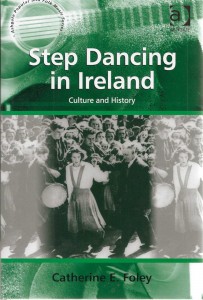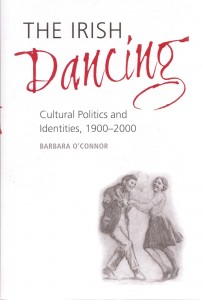STEP DANCING IN IRELAND: CULTURE AND HISTORY
Published in Book Reviews, Issue 6 (November/December 2015), Reviews, Volume 23Reviewed by Orfhlaith Ni Bhriain
A course director at the Irish World Academy of Music and Dance at the University of Limerick.


For many years dance scholarship has been considered as a luxury niche and largely undervalued, and even entirely omitted from written accounts depicting the importance of culture in the development of Irish society. The growth of ethnochoreology, however, as an independent discipline, which highlights the importance of dance scholarship worldwide, has increased the status of dance in academia, and dance scholars are coming to the fore in Ireland and globally. The publications reviewed below are a welcome addition to the burgeoning field and will serve to redress previous lacunae.
Catherine Foley’s text traces the trajectory of step dancing in Ireland from the end of the eighteenth century until the present day. Based on original fieldwork conducted in north Kerry in the late eighties and during the millennium year, it examines three distinct yet related step dance practices to illustrate how different manifestations of step dance can embody, express and shape culture and history. Effectively combining historical and ethnochoreological perspectives, it illuminates the traditional style of dance transmitted in north Kerry through the Molyneaux legacy, the competition-oriented practice perpetuated by the Rinceoirí na Ríochta Irish dance academy and the stylised folk theatrical practice of Siamsa Tíre.
The key themes of the study are cultural change, embodiment, habitus and identity. The analysis is informed by the author’s own dance expertise as a practitioner of the art form and by her academic skills in ethnochoreology. Oscillating between the standpoints of ‘insider’ and ‘outsider’, Foley does not seek objectivity; instead, she assumes the role of reflective performer and considers step dance as a dynamic form that expresses and embodies culture and identity. She combines rich ethnographic texts and careful consideration of key historical events in Kerry, in Ireland and abroad over a period spanning more than three centuries. The text is further enhanced through notated examples of dances and music transcriptions and an array of black-and-white photographs, which complement the poetic-thick description and reflective prose.
Although it has a specific local and geographic focus on north Kerry, the case-studies are all considered from local, national and global contexts. Binary oppositions that marked the cultural and ideological debate of twentieth-century Ireland are scrutinised through a lens of dance as culture. These relate to how Irish identity was contested through challenging perceptions of old/new, local/ global, and the transitions from rural to urbanised settings. Foley’s performance and academic backgrounds thus combine to bring this text to life for dance experts and enthusiasts and Irish history aficionados alike.
Similarly, Barbara O’Connor’s 2013 publication on the relationships between Irish dancing, cultural politics and identities serves to inform scholars across a variety of disciplines. Her well-presented book on Irish dance focuses on theatrical and social dance and interrogates how dance reflects upon and produces society and culture. It is framed by two significant markers in the history of Irish dance: the first céili held in Bloomsbury Hall, London, in 1897 and the Riverdance spectacle performed at the Point Theatre, Dublin, as an intermission act for the Eurovision Song Contest in 1994. It adopts a critical studies approach, which is partly thematic and partly chronological. The key themes relate to cultural identity and cultural politics, and there are also emergent discussions pertaining to gender and social class viewed through the lens of recreational dance by the Irish. The introductory chapters address the role of the dancing body in the construction and maintenance of national identity from the Cultural Revival in the 1890s through to the 1930s. The significant role of the Catholic Church in the control and regulation of recreational dance is also acknowledged. While dealing with many culturally specific practices within Ireland, it also highlights the significant role played by the Irish diaspora.
The book is broad in its scope and offers an overview of the Irish and their diaspora in terms of their deep relationship with dance over the course of the twentieth century. O’Connor draws on a variety of disciplines, including cultural studies, dance history and ethnochoreology, to complement her own sociological training. While this interdisciplinary approach is challenging, it is also one of the great strengths of the text. The author acknowledges the large scope of the phenomenon; she accepts that the text is not a comprehensive account of dance in the twentieth century but that the themes are selective in their inclusion and not systematically pursued. Neither is it a deep analysis of the dance movements performed by the dancers or inclusive of vast amounts of empirical research. Given its concentration on social and spectacle dance genres, it largely ignores the step dance genres, but includes illustrations from dance events in Ireland and abroad. It does, however, seek to highlight the voices of the dancers by including quotes from the set dancers and step dancers interviewed. It also sets out a clear cultural and historical context, explaining how Irish society evolved over the course of the twentieth century and also acknowledging significant international developments in music and dance studies. O’Connor is to be lauded for her engagement with dance and her significant contribution to interdisciplinary and dance scholarship within the academy.
















